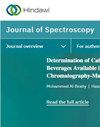Characterization of Natural Precious Opal Using Modern Spectroscopic Techniques in Ethiopia: The Case from Delanta, South Wollo
IF 2.1
4区 化学
Q4 BIOCHEMICAL RESEARCH METHODS
引用次数: 0
Abstract
The purpose of this study was to conduct characterization of the Delanta natural opals obtained from different mining sites. Characteristics of opals mined from different geological locality were examined. Six opal samples were collected from the main mining sites found in different localities from Delanta district and characterized using Fourier infrared spectroscopy, scanning electron microscopy, X-ray diffraction, and inductively coupled plasma optical emission spectroscopy characterization techniques. The scanning electron microscope micrographs showed that all the samples have relatively semi-ordered (semi-crystalline) structural surface morphologies composed of tiny spherical particles. The performed X-ray diffraction analysis showed that the samples have main peaks at 20.0°, 21.72°, 36.9°, 44.0°, and 56.85° with 2 θ values between 10° and 60°. The five diffraction peaks are characteristic peak positions of opal-CT. The Fourier infrared spectroscopy data indicated that the prominent absorption bands for cristobalite at 620 and 520 cm−1 were absent from the spectrum. Instead, three bands in the low frequency region centered at 470, 791, and 1100 cm−1 were observed because of the absorptions of the silicate framework (Si-O) vibrations. red−1−1 Moreover,spectra feature of molecular water and silanol (Si-OH) groups with broadabsorption band centered around 3447 cm-1 andthe O-H stretching vibration of watermolecules and water bending vibration withan absorption band centered around 1634 cm-1were observed.. These values were consistently comparable with literature data. The inductively coupled plasma optical emission spectroscopy analysis showed that four main impurities (>500 parts per million) were Ca (∼1,750–4,730 parts per million), Al (∼1,990–4,319 parts per million, K (∼1,670–3,895 parts per million), and Na (∼595–3,723 parts per million). In general, this study revealed that all opal samples taken from six mining sites in Delanta district were found to be opal-CT as per the results of X-ray diffraction and Fourier infrared spectroscopy investigations.用现代光谱技术表征埃塞俄比亚的天然珍贵蛋白石:来自南沃罗的德兰塔的案例
本研究的目的是对从不同矿区获得的德兰塔天然蛋白石进行表征。研究了不同地质产地蛋白石的特征。从Delanta地区不同地点的主要矿区采集了6个蛋白石样品,并利用傅里叶红外光谱、扫描电子显微镜、x射线衍射和电感耦合等离子体发射光谱表征技术对其进行了表征。扫描电镜显微图显示,所有样品都具有由微小的球形颗粒组成的相对半有序(半结晶)的结构表面形貌。x射线衍射分析表明,样品的主峰位于20.0°、21.72°、36.9°、44.0°和56.85°,2 θ值在10°~ 60°之间。这5个衍射峰是蛋白石ct的特征峰位。傅里叶红外光谱数据表明,方石英在620和520 cm−1处没有明显的吸收带。相反,由于硅酸盐骨架(Si-O)振动的吸收,在470、791和1100 cm−1的低频区域观察到三个波段。此外,还观察到了以3447 cm-1为中心的宽吸收带的水分子和硅烷醇(Si-OH)基团的光谱特征,以及以1634 cm-1为中心的吸收带内水分子的O-H拉伸振动和水的弯曲振动。这些值与文献数据一致。电感耦合等离子体发射光谱分析显示,四种主要杂质(>500 ppm)分别是Ca (~ 1,750-4,730 ppm)、Al (~ 1,990-4,319 ppm)、K (~ 1,670-3,895 ppm)和Na (~ 595-3,723 ppm)。总的来说,本研究表明,从Delanta地区六个矿区采集的蛋白石样品,根据x射线衍射和傅里叶红外光谱研究结果,发现所有蛋白石样品都是蛋白石ct。
本文章由计算机程序翻译,如有差异,请以英文原文为准。
求助全文
约1分钟内获得全文
求助全文
来源期刊

Journal of Spectroscopy
BIOCHEMICAL RESEARCH METHODS-SPECTROSCOPY
CiteScore
3.00
自引率
0.00%
发文量
37
审稿时长
15 weeks
期刊介绍:
Journal of Spectroscopy (formerly titled Spectroscopy: An International Journal) is a peer-reviewed, open access journal that publishes original research articles as well as review articles in all areas of spectroscopy.
 求助内容:
求助内容: 应助结果提醒方式:
应助结果提醒方式:


